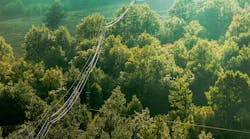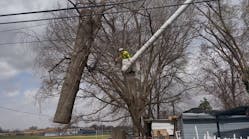Vegetation Inspection, a challenge for Utilities
In July 2022 the U.S. Department of Energy launched the operational phase of the grant program “Preventing Outages and Enhancing the Resilience of the Electric Grid[1]”. This was just one of the actions planned as part of the “Building a Better Grid Initiative”, launched in January by the Biden Administration. The program is set to provide 2.3 billion dollars over five years to States and Tribal nations for the reinforcement and modernization of the American electricity grid, making it more resilient against fires, extreme weather events and other natural disasters exacerbated by the climate crisis.
One of the main interventions financed by the program is the maintenance of pylons and the removal of trees and other vegetation that can affect the performance of the electricity grid.
As reported by The College of Nature Resources (CNUC), a research conducted with more than 60 utilities in the United States, 23% of the US’s energy outages[2] are related to vegetation, and such outages have a significant economic, environmental, and social impact.
This scenario is further complicated by extreme weather events, which are becoming increasingly frequent as a result of climate change, and their interaction with vegetation. During storms with strong winds or snow in the northeast United States, trees were responsible for a particularly high percentage of electricity outages, reaching up to 90% in heavily forested areas, such as Connecticut and New England[3].
Recent data from the US Energy Information Administration (EIA)[4] highlighted that in 2020 electricity customers in the US experienced on average more than eight hours of electricity outages, the highest levels ever recorded since the agency began collecting data on grid reliability in 2013. The main cause of disruptions was attributed to the weather and vegetation.
Within this context, the cost of an outage can add up to millions of dollars per hour. In fact, the Department of Energy has estimated that outages can cost the U.S. economy US$ 150 billion annually[5].
Thus, detecting vegetation located at critical distances from infrastructure is a crucial issue that Utilities must address to ensure the continuity and security of electricity supply and make the distribution network more resilient, optimize costs, and avoid regulatory fines.
We asked Santiago Cascante, Chief Commercial Officer at Gridspertise, a company founded in 2021 to provide DSOs of any size and geography with cutting-edge sustainable solutions for the digital transformation of electricity distribution networks.
Which solutions are available to Power grid operators to reduce outages caused by vegetation and optimize management costs?
“Today, Utilities spend around 6-8 billion dollars a year on vegetation management, according to a 2021 study by Accenture[6].
Using a smart and efficient vegetation inspection system is an essential tool to tackle this challenge. The key is to digitalize the processes: most Utilities still collect a large quantity of visual data and analyze it manually, a process that is both time-consuming and labor-intensive.
These procedures can be optimized and speeded up thanks to a set of integrated solutions that bring together digital tools, Artificial Intelligence and Machine Learning, like our Digital Asset and vegetation intelligence.
Our solution is based on a Network Digital Twin® which creates a virtual replica of the electricity grid and the surrounding environment, by acquiring and processing structured datasets provided by laser scanner, photography, videos etc. It enables the identification of critical distances and anomalies on specific components, detecting possible anomalies, facilitating vegetation inspection and predictive maintenance through anomaly recognition.
How does it work and what does it enable you to do?
“The solution is composed by 3 main features.
The global repository enables to upload, process and classify data by assigning a tag to each component of the grid.
The 3D Viewer is a rendering tool that enables the 3D “navigation” of the electricity grid as well as the substations, transformers and pole mounted.
The 3D modeling functions combined with Computer Vision enable the processing of all data readings and images, the automatic labeling of point clouds, the classification of data, measurement of the height profiles and distances between the electricity grid, the terrain below and the surrounding vegetation, as well as the recognition of assets and the detection of anomalies.
These tools enable visual inspection and simulations of the grid in different conditions, to detect critical distances between the infrastructure and surrounding trees and plants, as well as predicting failures of components through machine learning”.
What are the benefits of this solution?
“Our Digital Asset and vegetation intelligence offers a comprehensive vision of the conditions of the grid and makes it possible to make rapid, data-driven decisions about the need to perform inspections and vegetation management interventions. In particular, it is possible to identify all of the critical aspects concerning the distances between electricity lines and surrounding vegetation and plan regular trimming efficiently, in addition to monitoring trimming operations performed by subcontractors.
Recent statistical analyses have shown that improving vegetation management is essential to reduce electricity service outages of between 45.8% and 63.8% in the case of lower-severity storms. For high-severity events, however, adopting the highest level of vegetation analysis leads to a 37.3% reduction in trouble spots[7].
Our solution works precisely on this front, increasing efficiency, boosting the security of the service and speeding up response times. Based on our recent experience, the solution enabled an increase of operational efficiency: up to 16% savings on trimming operations, up to 15% savings for preventive and corrective maintenance and up to 50% for operations in the field.”
Gridspertise’s solutions will be featured at the 44th edition of the Minsait ACS Customer Conference, scheduled to take place in Orlando (Florida) from 18 to 22 September 2022.
[1] https://www.energy.gov/articles/biden-administration-announces-23-billion-states-and-tribes-strengthen-and-modernize
[2] https://www.researchgate.net/profile/Richard-Hauer-2/publication/350291004_Utility_Vegetation_Management_in_North_America_Results_from_a_2019_Utility_Forestry_Census_of_Tree_Activities_and_Operations/links/605910b3299bf173676082e2/Utility-Vegetation-Management-in-North-America-Results-from-a-2019-Utility-Forestry-Census-of-Tree-Activities-and-Operations.pdf?origin=publication_detail
[3] https://www.mdpi.com/2071-1050/14/2/904/htm#B2-sustainability-14-00904
[4] https://www.eia.gov/todayinenergy/detail.php?id=50316
[5] https://www.tdworld.com/vegetation-management/article/21239691/outsmart-vegetationrelated-power-outages
[6] https://www.accenture.com/us-en/blogs/accenture-utilities-blog/vegetation-management-key-levers-for-cost-savings#_ftn1
[7] https://www.mdpi.com/2071-1050/14/2/904/htm#B2-sustainability-14-00904
Sponsored by:



